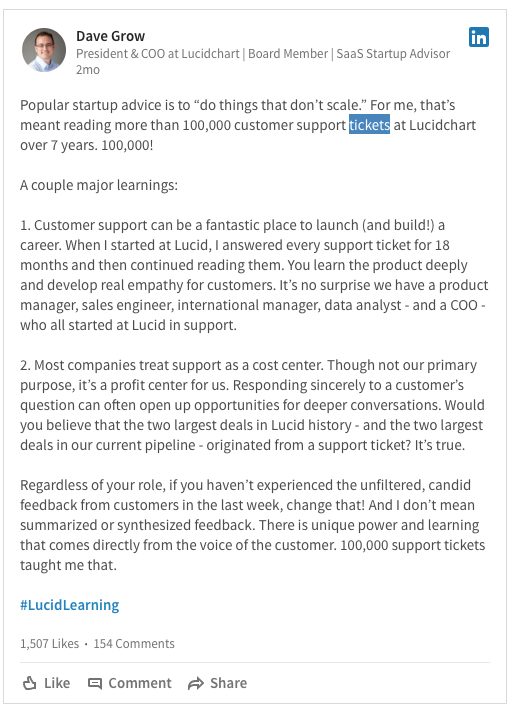We recently read a crazy Linkedin post from Dave Grow, COO of LucidChart. Dave took a common piece of advice for entrepreneurs “to do things that don’t scale,” and used it to better understand his customers. He has read more than 100,000 customer support tickets at LucidChart

As a CEO of a fast-growing startup, there’s a million other strategies and tactics that Dave could be doing, but he deliberately prioritized reading support tickets. He understands the value of building relationships and staying close to customers’ feedback.
Read Customer Feedback More Often!
Founders and CEOs grow their teams from a few employees to 100+, reading customer feedback can often get put on the backburner. This leads them to only look at a handful of data points where you can’t see the full picture and can desensitize them from real customer pain points.
There’s a fine line between unbridled optimism and delusion. Listening to customers’ feedback and what the larger market is saying (or in some cases isn’t saying) can keep you firmly grounded in reality.
CEOs, like Dave, understand this better than most.
In fact, their two biggest sales at Lucidchart came from support tickets.
“Responding sincerely to a customer’s question can often open up opportunities for deeper conversations. Would you believe that the two largest deals in Lucid history – and the two largest deals in our current pipeline – originated from a support ticket?”
It is a sales and innovation engine
Real relationships are how the biggest deals get made. You never know when that little support ticket can turn into a game-changing new feature or a $100,000 contract.
It will make you more empathic
Customer support done right breeds empathy and self-awareness. These are two of the biggest traits that every CEO or executive needs to be successful.
It is proactive not reactive support
No CEO likes to read negative comments about the product – be it through email, social media, review sites, etc. But guess what – reading and then responding genuinely to your negative feedback is going to make your product or service better.
Jordan Cook, a sales operations leader at InsideSales.com, started his career in support. His time in support helped him tremendously as a sales leader.
“I have personally seen accounts be saved, lasting relationships formed, and deals closed – all from the efforts of frontline product specialists – the unsung heroes of any good software company,” said Jordan in a comment on Dave’s post.
It builds customer loyalty
Great customer service builds brand loyalty (and in turn more sales).
On average, one happy customer tells nine people about their experiences with a company. Unhappy customers talk more and tell an average of 16 people.
When you respond and turn an unhappy customer into a happy one, you are not only savaging that relationship. You’ll also likely get a handful of new referrals.
You can measure customer loyalty using a survey metric such as Net Promoter Score (NPS). This short survey asks on a scale of 1-10 how likely you are to recommend this product or service to a friend.

It is a competitor differentiator
Dave’s company is known for providing great customer service. This not only helps them retain their current customers, but it is also a valuable sales asset.
People want to do business with people that they know, like and trust.
Great customer service is a relationship builder and marketing machine not a cost center. You don’t control your brand’s message, your customers do. The frontline is your customer service people.
You don’t control your brand’s message, your customers do. The frontline is your customer service people.
It keeps you from becoming complacent
This is the most important benefit, and the easiest to overlook. In this day and age, no brand is too big to fail.
You don’t have to look far to see an example of where a big brand became complacent for too long and it was their own demise. The most recent example is Toys ‘R Us. I grew up in the 1990s. I remember watching their jingles on TV and then begging my mom to take me to the toy store to buy more toys.
A Practical Approach to Getting Your Daily Dose of Feedback
Now that I’ve convinced you reading customer feedback is important, here’s a practical approach for how to build customer feedback into every single day in less than 15 minutes. Or, if you are an employee, how you can convince your CEO to do this every day.
Add several customer experience metrics into your company’s reporting dashboard:
Finally, if Jeff Bezos, Amazon’s CEO has the time to read through every piece of customer feedback emailed to him, what’s your excuse?



